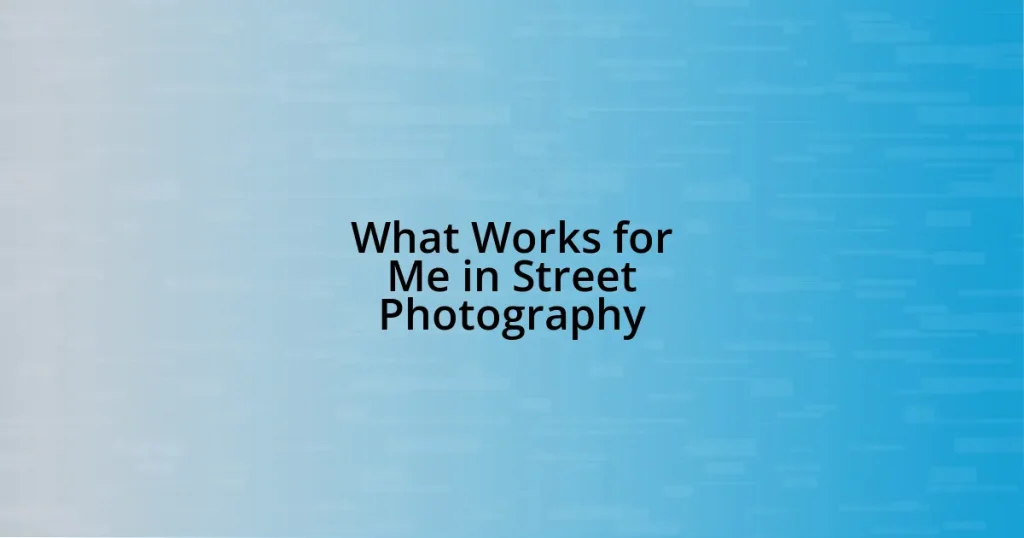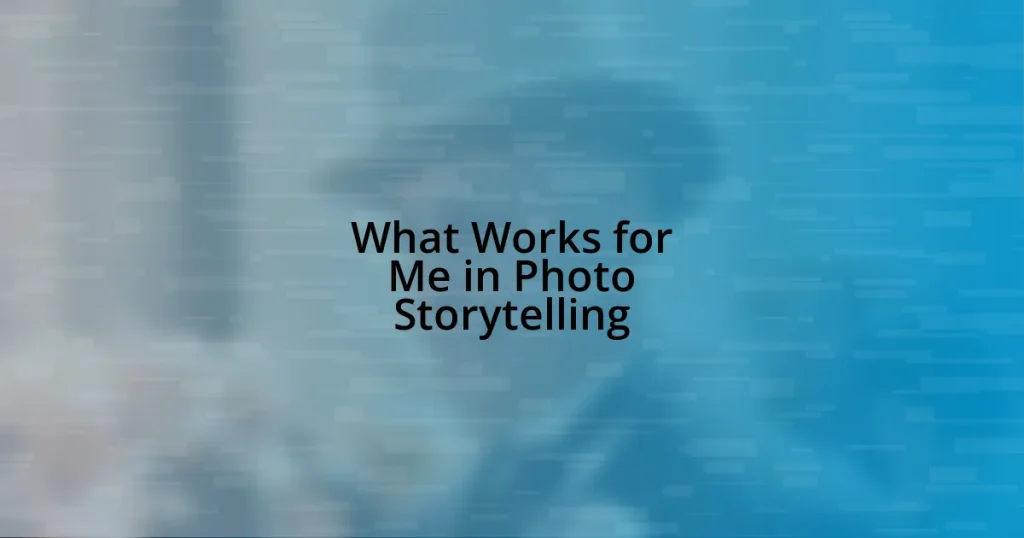Key takeaways:
- Documentation serves as a time capsule, allowing reflection on past experiences and emotional growth.
- Establishing a consistent routine, such as dedicated time for writing, enhances the documentation process.
- Techniques like mindful observation and using creative prompts enrich the capturing of moments and emotions.
- Adapting documentation practices over time is essential, influenced by life changes and advancements in technology.

Understanding the Importance of Documentation
Documenting life’s moments is essential because it allows us to savor experiences long after they’ve passed. I remember the first time I stumbled upon an old journal filled with my thoughts from high school. It was fascinating—and a bit nostalgic—to see how I viewed the world back then, reminding me of the growth I’ve experienced since. Isn’t it incredible how documentation can serve as a time capsule of our emotions and experiences?
Moreover, documentation can provide clarity during tumultuous times. There was a period in my life when everything felt chaotic. Writing down my feelings helped me process what was happening and regain perspective. Can you think of a situation where jotting down your thoughts made all the difference? It’s in those moments that we realize how powerful our own words can be.
Finally, I believe documentation fosters connections. When I share my stories with friends, I see their reactions and often learn something new about them in return. How many times have you shared a memory that sparked a deeper conversation? Documenting our lives not only preserves our history but also creates bonds through shared experiences and stories.

Establishing a Consistent Routine
Establishing a routine is vital to effective documentation. For me, setting aside a specific time each week to reflect and write ensures that I capture those fleeting moments before they fade. I remember how dedicating Sunday mornings to this practice transformed the way I approached my memories; it became a sacred time to process my week. Have you considered how a dedicated time might change your perspective on daily events?
Creating a supportive environment can enhance this routine. I found that surrounding myself with inspiring tools—my favorite pens and notebooks—made the experience more enjoyable. It’s funny how something as simple as lighting a candle while writing can turn an ordinary task into a cherished ritual. What atmosphere do you think would inspire your own documentation practice and help you stick with it?
To foster consistency, consider tracking your habits. I started using a bullet journal to mark off days when I successfully documented my thoughts. It’s rewarding to see the streaks grow, spurring me on to maintain that momentum. By recognizing progress, you’ll find motivation in your practice. How do you measure success in your routines?
| Routine Aspect | My Experience |
|---|---|
| Dedicated Time | Sunday mornings transformed my reflection |
| Supportive Environment | Candles and favorite pens enhance the experience |
| Tracking Habits | Bullet journals help visualize progress |

Techniques for Capturing Moments
Capturing those precious moments doesn’t always require fancy equipment—sometimes, it’s about being present and aware. One technique I’ve found invaluable is mindfulness; taking a moment to breathe and fully engage with my surroundings has led to some of my favorite snapshots, both written and photographic. There was a day at the beach when I closed my eyes, listened to the waves, and suddenly felt compelled to write down my emotions. That simple act of tuning in allowed me to document not just the scene but the feelings tied to it.
To enhance your moment-capturing skills, consider these techniques:
- Mindful Observation: Slow down and really take in your environment. Let your senses guide your writing.
- Capture Spontaneity: Always keep a small notebook or an app handy for those unexpected moments that spark inspiration.
- Use Prompts: Lately, I’ve been using creative prompts to spark my writing when I’m feeling uninspired. It helps shift my focus and see moments in new ways.
- Emotional Reflection: After a significant event, take time to reflect on your feelings. Write down how it impacted you and why it matters.
By employing these techniques, I’ve discovered that the more I engage with my environment emotionally, the richer my documentation becomes. It turns the mundane into something magical, encouraging me to cherish each little moment more deeply.

Organizing and Storing Your Content
Keeping your documented moments well-organized is essential for later reflection. I started using digital folders to categorize my experiences; one for family events, another for travels, and so on. It’s easy to forget the small details, but having everything sorted allows me to pull up memories effortlessly. Have you ever lost track of an important moment simply because it wasn’t filed away properly?
For physical documentation, I found that using scrapbook-style albums works wonders. Each page is a canvas where I can mix photos, tickets, and notes from an event. Just last week, I crafted a memory page for my niece’s birthday celebration, combining her laughter captured in a photo with little snippets of what we did that day. It’s a joyous way to relive moments! How do you plan to preserve your cherished memories?
Storing content in a way that feels accessible is key. I’ve invested in a cloud service for my digital writings, giving me peace of mind that my reflections are safe and can be retrieved easily. Knowing I can revisit old memories whenever I need a dose of nostalgia is comforting. What storage solutions resonate with you, and how might they help you in organizing your life’s moments?

Sharing and Reflecting on Memories
Sharing memories is one of the most rewarding experiences I know. I often find myself scrolling through old photos or reading past journal entries, not just to reminisce, but to reconnect with those feelings I once had. Isn’t it fascinating how a single snapshot can transport you back in time? I remember flipping through a travel journal and encountering a particular entry about a breathtaking sunset in Bali—it reminded me of the euphoria I felt in that moment, as if I could hear the waves crashing again.
Reflecting on memories can be a deeply emotional exercise. I often choose quiet moments to sit down with my documented experiences and simply absorb the stories behind them. There was a rainy afternoon when I pulled out my old photo album, and as I turned each page, I felt a wave of gratitude wash over me for the people and experiences I’ve had. Those memories serve as reminders of who I am and where I’ve been—something I think we all need from time to time. Have you ever had an experience where revisiting a memory brought a rush of emotions that surprised you?
The act of sharing these memories, whether through social media or intimate gatherings, can also deepen connections. I love gathering with friends to share stories from the past; we often end up laughing until we cry. It creates a special bond and helps us appreciate our journeys together. Just last month, we reminisced about a road trip mishap that turned into one of our funniest stories—those shared laughs were pure magic. How do you find joy in sharing your stories?

Adapting Your Process Over Time
Adapting your process for documenting life’s moments is truly a dynamic journey. I’ve found that what works for me now may not have suited my needs a few years ago. For example, after becoming a parent, my priorities shifted dramatically. I used to solely focus on travel experiences, but now, I also cherish documenting the little milestones of my child’s growth, like their first steps or funny mispronunciations. Have you experienced shifts in your life that changed how you document your moments?
Technology plays a huge role in this adaptation. I remember clinging to handwritten journals, thinking they were the ultimate way to capture my feelings. However, as my life became busier, I transitioned to using voice notes on my phone to quickly capture fleeting thoughts and experiences. Just the other day, I recorded a quick reflection about my daughter’s latest school performance during the drive home. It’s so practical! How has technology influenced the way you capture your memories?
Ultimately, it’s essential to periodically reevaluate and tailor your approach. I set aside a few moments each year to reflect on my documenting practices—do I feel fulfilled by them? Are there new tools or formats I want to explore? Last month, I decided to try making a photobook instead of just keeping digital files. Seeing those moments physically represented helped me create a tangible connection to my experiences. What changes have you contemplated to enhance your memory documentation process?
















